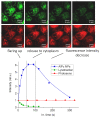Theranostic Properties of Crystalline Aluminum Phthalocyanine Nanoparticles as a Photosensitizer
- PMID: 36297557
- PMCID: PMC9611939
- DOI: 10.3390/pharmaceutics14102122
Theranostic Properties of Crystalline Aluminum Phthalocyanine Nanoparticles as a Photosensitizer
Abstract
The study of phthalocyanines, known photosensitizers, for biomedical applications has been of high research interest for several decades. Of specific interest, nanophotosensitizers are crystalline aluminum phthalocyanine nanoparticles (AlPc NPs). In crystalline form, they are water-insoluble and atoxic, but upon contact with tumors, immune cells, or pathogenic microflora, they change their spectroscopic properties (acquire the ability to fluoresce and become phototoxic), which makes them upcoming agents for selective phototheranostics. Aqueous colloids of crystalline AlPc NPs with a hydrodynamic size of 104 ± 54 nm were obtained using ultrasonic dispersal and centrifugation. Intracellular accumulation and localization of AlPc were studied on HeLa and THP-1 cell cultures and macrophages (M0, M1, M2) by fluorescence microscopy. Crystallinity was assessed by XRD spectroscopy. Time-resolved spectroscopy was used to obtain characteristic fluorescence kinetics of AlPc NPs upon interaction with cell cultures. The photodynamic efficiency and fluorescence quantum yield of AlPc NPs in HeLa and THP-1 cells were evaluated. After entering the cells, AlPc NPs localized in lysosomes and fluorescence corresponding to individual AlPc molecules were observed, as well as destruction of lysosomes and a rapid decrease in fluorescence intensity during photodynamic action. The photodynamic efficiency of AlPc NPs in THP-1 cells was almost 1.8-fold that of the molecular form of AlPc (Photosens). A new mechanism for the occurrence of fluorescence and phototoxicity of AlPc NPs in interaction with cells is proposed.
Keywords: aluminum phthalocyanine; fluorescence lifetime; nanoparticles; photosensitizer; phototheranostic; phototoxicity.
Conflict of interest statement
The authors declare no conflict of interest.
Figures








References
-
- Sosnik A. Drug Self-Assembly: A Phenomenon at the Nanometer Scale with Major Impact in the Structure–Biological Properties Relationship and the Treatment of Disease. Prog. Mater. Sci. 2016;82:39–82. doi: 10.1016/j.pmatsci.2016.03.004. - DOI
-
- Lamch Ł., Gancarz R., Tsirigotis-Maniecka M., Moszyńska I.M., Ciejka J., Wilk K.A. Studying the “Rigid–Flexible” Properties of Polymeric Micelle Core-Forming Segments with a Hydrophobic Phthalocyanine Probe Using NMR and UV Spectroscopy. Langmuir. 2021;37:4316–4330. doi: 10.1021/acs.langmuir.1c00328. - DOI - PMC - PubMed
-
- Snow A.W. Phthalocyanine Aggregation. In: Kadish K.M., Smith K.M., Guilard R., editors. The Porphyrin Handbook. Volume 17. Academic Press; Cambridge, MA, USA: 2003. pp. 129–176.
-
- Li X., Zheng B.-D., Peng X.-H., Li S.-Z., Ying J.-W., Zhao Y., Huang J.-D., Yoon J. Phthalocyanines as Medicinal Photosensitizers: Developments in the Last Five Years. Coord. Chem. Rev. 2019;379:147–160. doi: 10.1016/j.ccr.2017.08.003. - DOI
-
- Chan W.-S., Marshall J.F., Svensen R., Bedwell J., Hart I.R. Effect of Sulfonation on the Cell and Tissue Distribution of the Photosensitizer Aluminum Phthalocyanine. Cancer Res. 1990;50:4533–4538. - PubMed
Grants and funding
LinkOut - more resources
Full Text Sources

